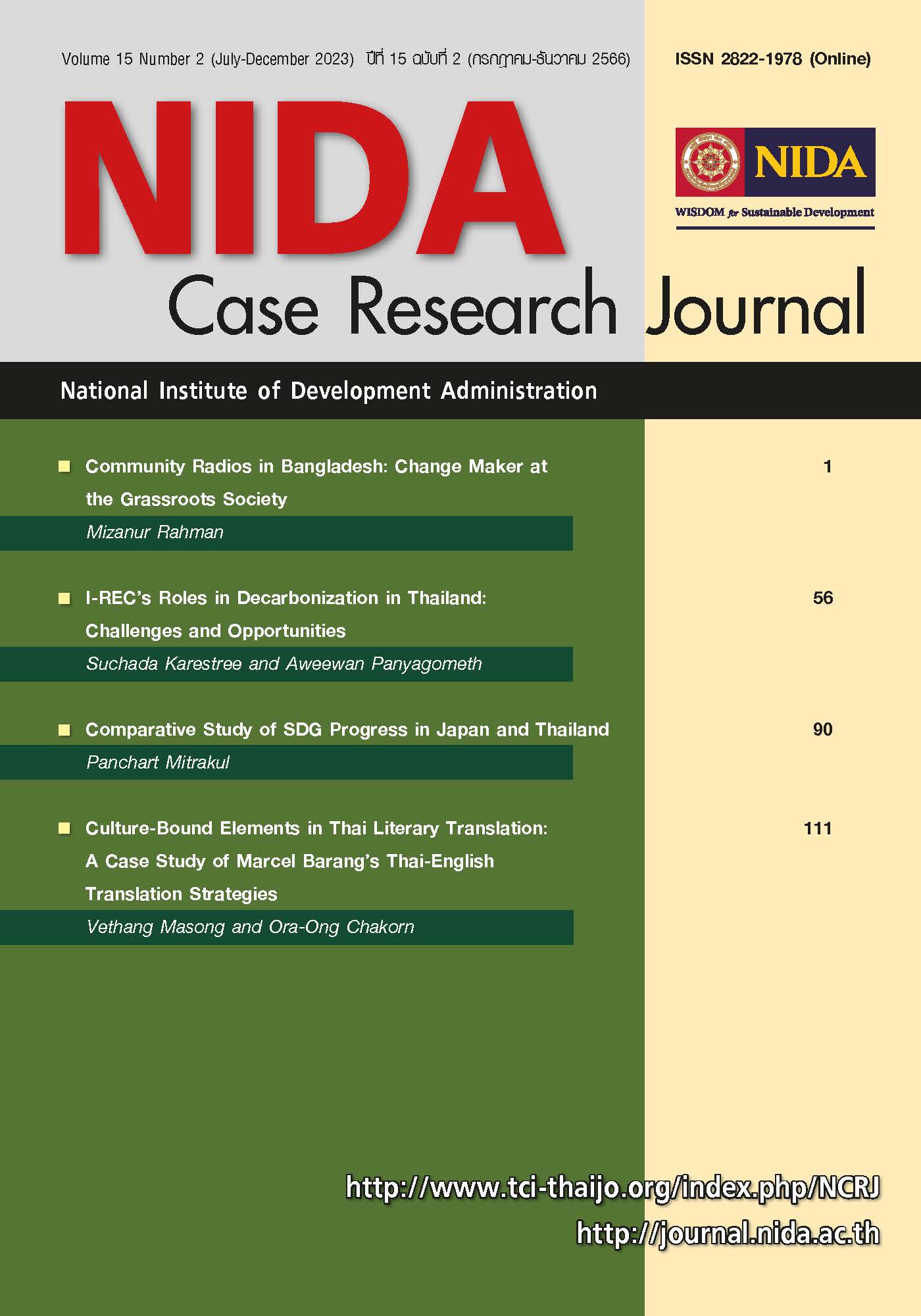Culture-Bound Elements in Thai Literary Translation: A Case Study of Marcel Barang’s Thai-English Translation Strategies
DOI:
https://doi.org/10.14456/ncrj.2023.8Keywords:
Literary Translation, Culture-bound Elements, Translation StrategiesAbstract
The purpose of this study was twofold: a) to create and propose a typology of culture-bound elements in two Thai literary texts that were translated into English by the non-Thai literary translator, Marcel Barang; and b) to deeply explore and propose a taxonomy of translation strategies that the translator adopted when dealing with culture-bound elements. The findings revealed eleven types of culture-bound elements, including: 1) Buddhism, comprising nine subcategories; 2) proper names, consisting of eight subcategories; 3) cultural artifacts; 4) figurative language, consisting of four subcategories; 5) onomatopoeic words; 6) sex, containing three subcategories; 7) swearwords; 8) music and arts; 9) greeting expressions; 10) units of measurement; and 11) others. Four types of culture-bound elements emerged from this study: figurative language, onomatopoeic words, sex, and swearwords. Regarding translation strategies, it was found that the translator adopted eleven strategies: 1) description, 2) transposition, 3) combined strategies, 4) superordinate, 5) literal translation, 6) definition, 7) transliteration, 8) reduction, 9) subordinate, 10) omission, and 11) alteration. The analysis of translation strategies demonstrated that foreignizing strategies were dominantly adopted in the transference of the culture-bound elements in the selected literary texts while domesticating strategies were used infrequently. It could be summarized that the translator tended to adopt a target-text-oriented style as shown in a series of efforts to facilitate the target audiences by not allowing the foreignness or strangeness of the source culture to affect their enjoyment.
References
Aixela. (1996). Culture-specific items in translation. In R. Alvarez & M. C.-A. Vidal (Eds.), Translation, power, subversion (pp. 52-78). Multilingual Matters.
Aixela. (1997). Culture-specific items in translation In R. Alvarez & M. Carmen-Africa Vidal (Eds.), Translation, Power, Subversion (pp. 52–78). Multilingual Matters.
Al-Masri, H. (2009). Translation and cultural equivalence: A study of translation losses in Arabic literary texts. Journal of Universal Language, 10(1), 7-44.
Antonini, R., & Chiaro, D. (2005). The quality of dubbed television programmes in Italy: The experimental design of an empirical study. Cross-Cultural Encounters: Linguistic perspectives, Roma: Officina Edizioni, 33-44.
Asawawongkasem, P. (2015). Sex and censorship: Translating taboo languages in E.L. James’s Fifty Shades of Grey. (Unpublished master's thesis). Chulalongkorn University, Bangkok.
Baker, M. (1992). In other words: A coursebook on translation. Routledge.
Bendus, M. (2012). The semantics and pragmatics of translating culture-bound references in film dubbing (Order No.3544654). (Doctoral Dissertation, Purdue University). ProQuest Dissertations and Theses Global.
Charoennitniyom, M. (2009). Translation methods for Thai cultural words and phrases in non-fiction, case study: Very Thai: Every popular culture (Unpublished master's thesis). Chulalongkorn University, Bangkok.
Chesterman, A. (1997). Memes of translation: The spread of ideas in translation theory. John Benjamins Publishing Company.
Cuddon, J. A., & Preston, C. E. (Eds.). (1999) The Penguin Dictionary of Literary Terms and Literary Theory. Penguin Books.
Díaz-Cintas, & Remael, A. (2007). Audiovisual translation: subtitling. St. Jerome Publishing.
Guerra, A. F. (2012). Translating cultural: problems, strategies, and practical realities. . SIC: A Journal of Literature, Culture and Literary Translation, 1(3), 1-27.
Hejwowski, K. (2004). The cognitive theory of translation. Wydawnictwo Naukowe PWN.
Hsieh, H.-F., & Shannon, S. E. (2005). Three approaches to qualitative content analysis Qualitative Health Research, 15(9), 1277-1288. doi:10.1177/1049732305276687
Johnson, A. L. (1976). Allusion in poetry. PTL: A Journal for Poetics and Theory of Literature, 1, 580-581.
Kebboonkerd, M. (2014). A study of strategies in translation of cultural words: A case study of The Kite Runner (Unpublished master’s thesis). Chulalongkorn University, Bangkok.
Kosunen, R., & Väisänen, S. (2001). Kääntämisen opetussanasto. Turku: Universidad de Turku.
Krings, H. P. (1986). Translation Problems and Translation Strategies of Advanced. In J. House & S. Blum-Kulka (Eds.), Interlingual and intercultural communication: Discourse and cognition in translation and second language acquisition studies (pp. 263-275). Gunter Narr.
Kwiecińnski, P. (2001). Disturbing strangeness: Foreignisation and domestication in translation
procedures in the context of cultural asymmetry: Edytor.
Lörscher, W. (1991). Translation performance, translation process, and translation strategies: A psycholinguistic investigation. TTR: Traduction, Terminologie, Rédaction, 5(1), 271–275.
Mailhac, J.-P. (1996). The formulation of translation strategies for cultural references. In C. Hoffmann (Ed.), Language, culture and communication in contemporary Europe (pp. 131-151). Multilingual Matters.
Manketwit, T. (2010). The analysis of the translation of culture-related words from the English version of Four Reigns (Si Phaendin) by Tulachandra (Unpublished master’s thesis). Chulalongkorn University, Bangkok.
Munday, J. (2001). Introducing translation studies: Theories and applications. Routledge.
Nagavajara, C. (1996). Comparative literature from a Thai perspective. Collected articles 1978–1992. Chulalongkorn University Press.
Nedergaard-Larsen, B. (1993). Culture-bound problems in subtitling. Perspectives: Studies in Translatology, 2, 207–241.
Newmark, P. (1988). A textbook of translation. Prentice-Hall International.
Nida, E. A. (1964). Toward a science of translating: with special reference to principles and procedures involved in Bible translating. E. J. Brill.
Nord, C. (1997). Translating as a purposeful activity: Functionalist approaches explained. St. Jerome.
Olk, H. (2013). Cultural references in translation: a framework for quantitative translation analysis. Perspectives, 21, 344 - 357.
Pedersen, J. (2007). Scandinavian Subtitles: A Comparative Study of Subtitling Norms in Sweden and Denmark with a Focus on Extralinguistic Cultural References. (Doctoral Dissertation). Retrieved from http://urn.kb.se/resolve?urn=urn:nbn:se:su:diva-7159
Pinmanee, S. (2019). Language, culture and translation: Thai-English. Chulalongkorn University Press.
Prateepachitti, K. (2014). Translating English idioms in The Secret History by Donna Tartt (Unpublished master’s thesis). Chulalongkorn University, Bangkok.
Ranzato, I. (2013). The translation of cultural references in the Italian dubbing of television series. (Doctoral Dissertation). Imperial College London, London.
Sahaphongse, P. (2011). A study of strategies in translation of cultural words: A case study of the Little House Series (Unpublished master’s thesis). Chulalongkorn University, Bangkok.
Vinay, J.-P., & Darbelnet, J. (2000). A methodology for translation. In L.Venuti (Ed.), The Translation Studies Reader (pp. 84-95). Routledge.
White, E.D. (2016). Subtitles and the cultural referent in Francophone cinema (Order No.10156595). (Doctoral Dissertation, Michigan State University). ProQuest Dissertations and Theses Global.
Downloads
Published
How to Cite
Issue
Section
License
Copyright (c) 2023 NIDA Case Research Journal

This work is licensed under a Creative Commons Attribution-NonCommercial-NoDerivatives 4.0 International License.





